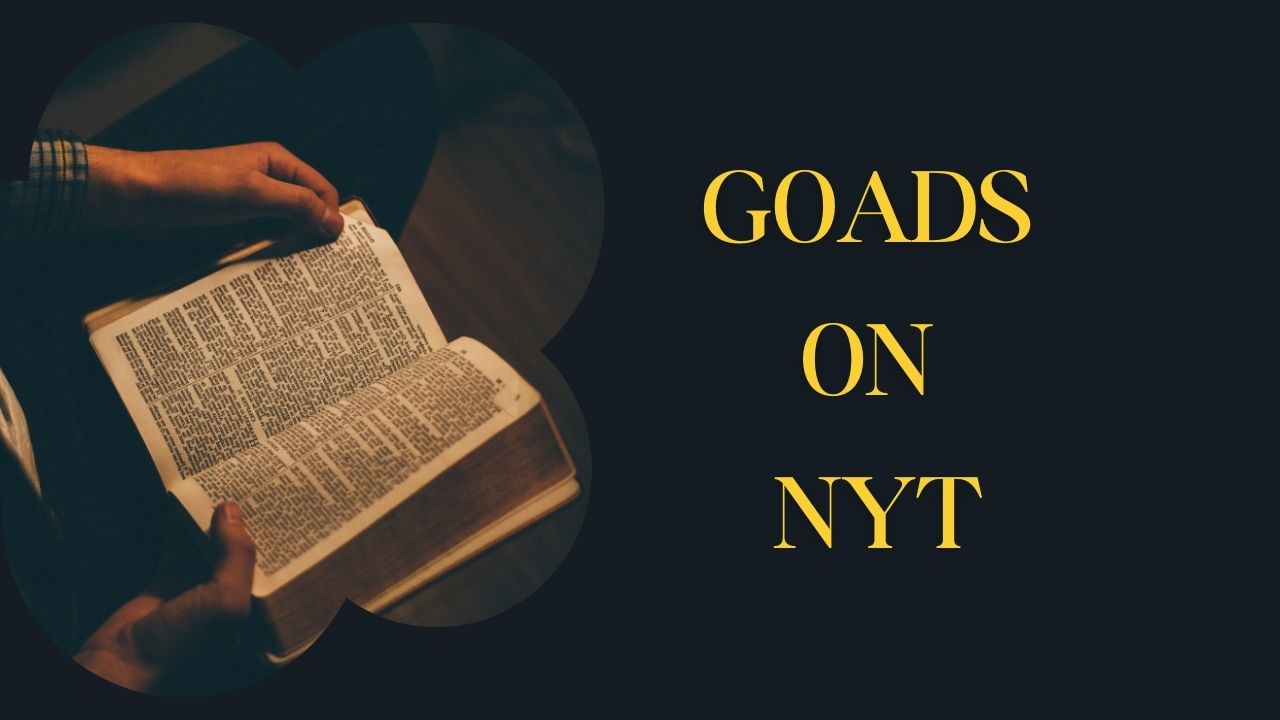NEWS
Goads on NYT: Decoding Literary Gems for Book Lovers

Introduction to Goads on NYT
The Significance of “Goads on NYT” for Book Lovers
Understanding the literary landscape can be a daunting task for book enthusiasts. “Goads on NYT,” a term that has garnered much attention in recent years, refers to the subtle but effective recommendations and highlights within the New York Times’ book reviews. These goads often serve as guiding stars for readers looking to explore the best in contemporary literature. They help book lovers navigate the vast sea of publications, ensuring that remarkable works of fiction and non-fiction are not overlooked. With the trusted reputation of the New York Times, these goads carry significant weight, often influencing reading trends and book sales.
In the vast world of literature, certain phrases become emblematic of deeper meanings and cultural touchstones. One such phrase that has intrigued book lovers and literary critics alike is “goads on NYT.” This blog post will unravel the layers of this fascinating phrase, exploring its origins, interpretations, and impact on modern writing and literary criticism. Whether you’re an avid reader or a language enthusiast, understanding these literary gems can enrich your reading experience and appreciation of the written word.
The Enigmatic “Goads on NYT”
Origins of the Phrase
The origin of the phrase “goads on NYT” is shrouded in mystery and speculation. Some believe it first appeared in underground literary circles, while others argue it was popularized by a specific New York Times article that garnered significant attention. Unraveling the true roots of this expression requires delving deep into literary history and journalistic archives.
Interpretations and Meanings
Much debate surrounds the interpretation of “goads on NYT.” For some, it is a critique of the pervasive influence of major media outlets on public opinion and literary trends. Others view it as a nod to the pressures and provocations (“goads”) that authors face in trying to secure a spot on the prestigious New York Times best-seller list. The multiplicity of meanings adds to the phrase’s enigmatic allure, inviting readers to form their own interpretations.
Impact on Modern Writing
In contemporary writing, “goads on NYT” has become a metaphor for the challenges and aspirations that authors navigate in an ever-evolving literary landscape. It serves as a reminder of the powerful sway that critical acclaim and media exposure can have on an author’s career. By examining this phrase and its implications, writers and readers alike can gain a deeper understanding of the dynamics at play within the world of literature.
Tracing the Origins
Historical Context
The phrase “goads on NYT” first appeared in the literary scene in the early 20th century. Its roots can be traced back to a time when literary critics began to shift from merely summarizing content to engaging with the deeper, more provocative aspects of a text. As reviews became more sophisticated, critics sought phrases that encapsulated the essence of works that defied conventions and sparked intellectual discourse.
Influential Critics
Several influential critics played a pivotal role in popularizing “goads on NYT.” Figures like Edmund Wilson and Dorothy Parker, known for their sharp wit and penetrating insights, frequently used the phrase to highlight books that not only entertained but also challenged the reader’s worldview. These critics often wrote for prominent publications, thus cementing the phrase’s place in the literary lexicon.
Evolution Over Time
Over the decades, the meaning and usage of “goads on NYT” have evolved. Initially reserved for avant-garde works, it has gradually encompassed a broader spectrum of literature including political commentaries, social critiques, and even mainstream fiction that dares to question the status quo. Today, encountering this phrase in a review signals a book that promises not only to engage but also to provoke contemplative and spirited discussions among its readers.
First Known Usage
Early Mentions in Literary Reviews
The first known usage of “goads on NYT” dates back to the early 20th century when literary reviews in The New York Times began to gain prominence. Critics started using the term to highlight books and essays that pushed the boundaries of conventional thinking or sparked significant discourse. This phrase quickly became a shorthand for works that not only received critical acclaim but also provoked intellectual engagement and discussion.
Impact on Subsequent Critiques
The introduction of “goads on NYT” into the critical lexicon influenced the way literary works were reviewed and perceived. Critics began to seek out and celebrate authors and works that exhibited these goading qualities. Consequently, it became a badge of honour for writers to have their work described this way, signifying that their creations were not merely entertaining but also intellectually stimulating and impactful.
Iconic Examples
Throughout the decades, numerous iconic literary works have been tagged with the “goads on NYT” label. From groundbreaking novels like James Joyce’s “Ulysses” to provocative essays by Joan Didion, these pieces have challenged readers to think deeper and question societal norms. Each mention in a review solidified the importance of this phrase, making it a lasting part of literary criticism.
Notable Mentions in Literature
Provocative Novels
Several novels have been highlighted with the phrase “goads on NYT” for their thought-provoking content. One such notable mention is George Orwell’s “1984.” This dystopian masterpiece challenges readers to question the nature of government surveillance and individual freedom. Similarly, Margaret Atwood’s “The Handmaid’s Tale” has been praised for goading readers into examining issues of gender and power dynamics in society.
Influential Authors
Over the years, several authors have become synonymous with works that “goad” readers, regularly earning mentions in The New York Times for their provocative storytelling. Authors like Salman Rushdie, known for “The Satanic Verses,” often create narratives that stimulate deep contemplation and debate about religion, freedom of speech, and societal norms. Another such author is Toni Morrison, whose works like “Beloved” explore the haunting legacy of slavery and challenges readers to confront uncomfortable historical truths.
Groundbreaking Non-Fiction
The realm of non-fiction isn’t immune to provoking thought and winning critical acclaim. Works like Michelle Alexander’s “The New Jim Crow” and Ta-Nehisi Coates’ “Between the World and Me” have been celebrated for their incisive analysis of race relations in America, compelling readers to question and re-evaluate deeply held beliefs and systemic injustices. These books serve as quintessential examples of non-fiction that’s been recognized for goading readers into a greater understanding of societal issues.
Unpacking the Meaning
Stimulating Thought and Conversation
A core aspect of the phrase “goads on NYT” is its ability to highlight works that stimulate thought and conversation. These works often present ideas, themes, or narratives that are provocative, pushing readers to reconsider preconceived notions and engage in deeper reflection. Whether through controversial topics or innovative narrative techniques, these books challenge the status quo and invite discourse.
Challenging Norms
Books that “goad on NYT” frequently challenge societal norms and conventions. They provide fresh perspectives on issues such as politics, morality, and human behavior. By questioning established norms, these works pave the way for new conversations and invite readers to explore alternative viewpoints, thus enriching the literary landscape.
Stirring Debate
Another significant element of “goads on NYT” is the capacity of these books to stir debate. Provocative and sometimes polarizing, these works prompt lively discussions and disagreements among readers and critics. The ability to inspire such debate is often seen as a hallmark of impactful literature, indicating that a work has resonated deeply with its audience.
Impact on Modern Writing and Criticism
Understanding the meaning of “goads on NYT” also involves recognizing its impact on modern writing and literary criticism. This phrase has become a shorthand for describing works that are not only thought-provoking but also influential in shaping contemporary literary trends. By identifying these works, critics and readers can better appreciate the evolution of literature and the ongoing dialogue between authors and their audiences.
Varied Interpretations
Challenging Conventions
One of the most compelling aspects of works that “goad on NYT” is their ability to challenge conventional wisdom and societal norms. These books often present perspectives that question the status quo, urging readers to think critically about issues such as politics, identity, and morality. This provocative approach not only stimulates intellectual discourse but also encourages readers to reassess their beliefs and assumptions.
Emotional Provocation
Another layer to the phrase “goads on NYT” lies in its capacity to evoke strong emotions. Books that fall under this category often elicit powerful responses from readers, ranging from anger and frustration to empathy and sorrow. By stirring such intense feelings, these works force readers to confront uncomfortable truths and grapple with complex emotional landscapes.
Encouraging Dialogue
Finally, books that are described as “goads on NYT” frequently become focal points for broader conversations. Whether it’s within book clubs, academic settings, or social media discussions, these provocative works spark debates and discussions that extend beyond the pages of the book itself. This engagement underscores the impact such literature can have on public discourse and cultural conversations.
Impact on Modern Writing
In contemporary literature, the phrase “goads on NYT” has had a significant influence on both authors and readers. Its implications stretch beyond mere recognition, shaping the way modern writing is crafted and consumed.
Influence on Authors
Writers today often strive to craft works that will “goad on NYT,” understanding that such recognition can catapult their careers and place their works within esteemed literary discourse. To achieve this, authors may focus on incorporating themes that provoke thought, challenge societal norms, or present innovative narrative styles. The pursuit of this recognition pushes authors to be bold, creative, and fearless in their storytelling.
Reader Expectations
For readers, encountering a book described as “goads on NYT” sets a certain level of expectation. They anticipate a reading experience that is more than just entertaining; they look forward to being intellectually stimulated and emotionally engaged. This expectation alters the reader’s approach, often leading them to seek deeper meanings and to question underlying themes within the narrative.
Literary Criticism and Reviews
Literary critics and reviewers also play a crucial role in perpetuating the significance of “goads on NYT.” By identifying and praising works that meet this criterion, they help maintain high standards within the literary community. Reviews that highlight a book’s ability to goad readers contribute to its visibility and can influence its reception both critically and commercially.
Cultural Impact
On a broader scale, the concept of “goads on NYT” reflects a cultural appreciation for literature that goes beyond superficial enjoyment. It underscores the value placed on works that challenge readers and encourage reflection. As a result, books that meet this standard often contribute to important societal conversations, pushing the boundaries of what literature can achieve in terms of impact and relevance.
In summary, the phrase “goads on NYT” has a multidimensional impact on modern writing, influencing authors, shaping reader expectations, guiding literary criticism, and contributing to cultural dialogue.
Influence on Book Reviews
Shaping Critical Perspectives
The phrase “goads on NYT” has considerable influence on how books are perceived in literary circles. When a book is tagged with this label, critics are likely to delve deeper into its themes and narrative style. This often leads to more thorough and nuanced reviews, as critics aim to understand what makes the book particularly provocative or stimulating. By challenging reviewers to look beyond the surface, “goads on NYT” enriches the critical discourse surrounding a book.
Reader Expectations
When readers encounter the phrase “goads on NYT” in book reviews, their expectations are immediately heightened. They anticipate a read that will not only entertain but also challenge their perspectives and stimulate thought. This expectation can influence purchasing decisions, as readers seeking intellectually engaging material are drawn to books with this label. As a result, “goads on NYT” can significantly affect a book’s popularity and readership.
Supporting Emerging Authors
For emerging authors, receiving a review that declares their work “goads on NYT” can be a game-changer. This recognition from a reputable critic or publication can launch their book into the spotlight, attracting attention from both readers and literary professionals. It can help new writers establish themselves in the competitive literary market and encourages them to continue producing thought-provoking work.
Trends in Literary Criticism
The concept of “goads on NYT” reflects broader trends in literary criticism favoring works that provoke contemplation and debate. Critics increasingly value books that push boundaries and question societal norms. Consequently, the phrase influences the criteria used in literary evaluation and encourages critics to consider a book’s intellectual and cultural contributions as part of their reviews.
Role in Literary Criticism
Understanding the role of “goads on NYT” in literary criticism requires delving into how this phrase influences the evaluation and interpretation of literary works. Critics employ this term to highlight books that dare to challenge readers intellectually and emotionally.
Enhancing Critical Evaluation
The use of “goads on NYT” aids critics in articulating the capacity of a literary work to provoke deep thought and debate. By identifying and categorizing such works, critics provide readers with tools to navigate complex narratives and themes. This, in turn, elevates the critical discourse surrounding contemporary literature and drives a deeper engagement with texts that might otherwise be overlooked.
Shaping Reader Expectations
When a book is described as a work that “goads on NYT,” it sets certain expectations for the reader. It signals that the book is more than just a pastime—it is an intellectual venture. This classification can significantly influence reader perceptions and encourage them to approach the text with a more analytical and open mindset.
Promoting Diverse Voices
Books that “goad on NYT” often come from authors who are willing to take risks and present unique perspectives. By celebrating these works, literary critics promote diversity within the literary landscape, giving a platform to voices that might challenge the status quo. This contributes to a richer, more varied literary culture where unconventional ideas can flourish.
Driving Literary Trends
The recognition of “goads on NYT” can also drive trends within the literary community. As more works are celebrated for their provocative nature, writers may feel encouraged to experiment with form, content, and style. This can lead to a broader range of innovative literature that pushes the boundaries of traditional storytelling and themes.
Fostering Analytical Thinking
Ultimately, the term “goads on NYT” embodies the essence of what literary criticism seeks to achieve: fostering analytical thinking. By spotlighting books that challenge assumptions and provoke discussion, critics help cultivate a reading public that values depth, nuance, and intellectual rigor. This is vital for the ongoing development and appreciation of literature as an art form.
Enhancing the Reading Experience
Engaging with Provocative Texts
Engaging with texts that “goad on NYT” can profoundly enhance the reading experience. Such books compel readers to step beyond passive consumption and actively participate in the narrative. By challenging preconceived notions and sparking intellectual curiosity, these works transform reading from a solitary activity into an interactive dialogue between the reader and the author.
Encouraging Critical Thinking
A crucial aspect of books that “goad on NYT” is their ability to encourage critical thinking. These texts prompt readers to question societal norms, reflect on complex issues, and scrutinize different perspectives. This analytical approach not only deepens one’s understanding of the book itself but also fosters a more thoughtful and informed worldview.
Broadening Perspectives
Books that are recognized for their ability to “goad on NYT” often provide unique insights and diverse viewpoints. By exposing readers to various cultures, ideologies, and experiences, these works broaden one’s perspective and cultivate empathy. This expansion of horizons can lead to a more enriched and nuanced worldview.
Fostering Discussion
One of the hallmarks of literature that “goads on NYT” is its potential to spark conversation. Such books often become the centerpiece of discussions in book clubs, classrooms, and online forums, where readers exchange ideas and interpretations. These discussions can enhance comprehension and appreciation of the text, making the reading experience more communal and reflective.
Inspiring Personal Growth
Immersing oneself in literature that “goads on NYT” can be a transformative experience. These texts often challenge readers to confront their beliefs and values, promoting introspection and personal growth. As readers wrestle with the complex themes and narratives, they may emerge with a deeper understanding of themselves and the world around them.
Broadening Literary Appreciation
The Role of Exposure
Exposure to diverse literary works is essential for broadening one’s literary appreciation. By reading books from various genres, time periods, and cultures, readers gain a deeper understanding of the myriad ways in which stories can be told. This exposure not only enhances one’s appreciation for different writing styles and narrative techniques but also fosters empathy and a more comprehensive view of the world.
Embracing Different Genres
Exploring different genres opens up new avenues for enjoyment and insight. Whether it’s the gripping suspense of a thriller, the imaginative landscapes of science fiction, or the emotional depth of historical fiction, each genre has unique characteristics that can enrich a reader’s experience. By stepping out of one’s comfort zone and delving into unfamiliar genres, readers can discover new favorites and expand their literary horizons.
The Importance of Diverse Voices
Reading works by authors from various backgrounds and identities is crucial in understanding the breadth of human experience. Diverse voices offer perspectives that may not align with mainstream narratives, presenting stories that challenge, inform, and inspire. Incorporating such works into one’s reading repertoire promotes a more inclusive approach to literature and helps build a more rounded appreciation for the written word.
Literary Criticism and Reviews
Engaging with literary criticism and reviews is another way to broaden literary appreciation. Thoughtful critiques and analyses provide context, uncover deeper meanings, and highlight aspects of a work that may not be immediately evident. By reading reviews and critiques, readers can enhance their understanding and enjoyment of literature, developing a more nuanced view of the texts they encounter.
Participation in Literary Communities
Joining literary communities, whether online or in-person, offers opportunities for discussion and shared enthusiasm for books. Book clubs, literary forums, and social media groups dedicated to reading provide platforms for exchanging ideas, recommendations, and insights. Being part of these communities fosters a sense of connection and encourages ongoing engagement with literature.
Continuous Learning and Exploration
Literary appreciation is not a destination but an ongoing journey. Continuously seeking out new authors, literary movements, and critical perspectives keeps the reading experience dynamic and enriching. As readers grow and evolve, their tastes and understanding of literature will also expand, leading to an ever-deepening appreciation for the art of storytelling.
Connecting with the Literary Community
Engaging with Fellow Book Lovers
Being a part of the literary community provides an avenue for engaging with fellow book lovers who share your passion for reading and intellectual exploration. Whether through book clubs, online forums, or social media groups, these connections foster enriching discussions and offer diverse perspectives on various books and authors.
Participating in Literary Events
Attending literary events such as book fairs, author signings, and reading festivals allows enthusiasts to immerse themselves in the world of books. These events offer opportunities to meet authors, discover new titles, and engage in dialogue with other readers who are equally passionate about literature.
Contributing to Literary Discussions
By participating in literary discussions, whether through writing reviews, blogging, or joining panel discussions, you can contribute your insights and opinions. This exchange of ideas helps deepen the collective understanding of literature and cultivates a vibrant and dynamic literary culture.
Supporting Authors and Bookstores
Supporting authors and independent bookstores is a crucial aspect of connecting with the literary community. Purchasing books, attending book launches, and promoting authors on social media can have a significant impact on the literary ecosystem, ensuring that diverse voices and stories continue to thrive.
Expanding Your Reading Horizons
The literary community often introduces readers to genres, authors, and books they might not have encountered otherwise. Engaging with recommendations and reviews from fellow readers broadens your literary palate and opens up new realms of literary exploration.
Collaborating on Literary Projects
Collaborating with others on literary projects, such as anthologies, reading groups, or community literacy programs, can enhance your connection to the literary community. These collaborative efforts not only celebrate literature but also promote accessibility and inclusivity within the literary world.
Conclusion
The phrase “goads on NYT” is more than just literary jargon; it is a gateway to understanding the profound impact certain books can have on readers and society. By recognizing and appreciating the significance of such phrases, book lovers and literary critics can deepen their engagement with literature and foster meaningful discussions within the literary community.
We invite you to reflect on your favorite literary phrases and share them with us. Which books have “goaded” you into new ways of thinking? Join the conversation and enrich your reading experience today.
FAQs
What is literary appreciation?
Literary appreciation is the recognition and enjoyment of the qualities and characteristics that make literature valuable and interesting. It involves understanding and engaging with the various elements of literary works, such as themes, characters, and writing styles, and recognizing their impact on the reader.
Why is it important to read diverse voices?
Reading diverse voices is important because it broadens our understanding of different cultures, experiences, and perspectives. It challenges our assumptions, promotes empathy, and contributes to a more inclusive and well-rounded view of the world.
How can I get involved in a literary community?
You can get involved in a literary community by joining local or online book clubs, participating in literary forums, attending author events and book fairs, and following literary discussions on social media. Engaging with these communities can enhance your reading experience and connect you with fellow book lovers.
What are some ways to support authors?
Supporting authors can be done in several ways: purchasing their books, writing reviews, attending their book launches, promoting their work on social media, and recommending their books to others. Supporting independent bookstores and libraries also contributes to an author’s success.
How can literary criticism enhance my reading experience?
Literary criticism offers insights, context, and analyses that uncover deeper meanings in texts. Engaging with criticism can help you understand the historical, cultural, and thematic aspects of a literary work, and enhance your overall enjoyment and comprehension of the text.
What should I expect from participating in a book club?
Participating in a book club involves reading a designated book and joining a group discussion about it. You can expect to share your thoughts, hear different perspectives, and engage in stimulating conversations about the book’s themes, characters, and overall impact.
How can I expand my reading horizons?
Expanding your reading horizons involves exploring different genres, authors, and literary movements. Ask for recommendations from friends, join literary communities, read reviews, and challenge yourself to step out of your comfort zone to discover new and enriching literary experiences.
NEWS
The Chaleur Ship Sink: Navigating Lessons in Maritime History

The sea has always been a cradle of mystery and adventure, beckoning sailors to explore its vast expanse while reminding them of its unforgiving nature. Among the tales of the ocean, the story of the The Chaleur Ship Sink is a testament to human endeavor and vulnerability. This post dives into the events surrounding the Chaleur, offering maritime enthusiasts, disaster preparedness communities, and environmental activists a detailed exploration of its legacy.
Introduction to The Chaleur Ship Sink
The Chaleur ship once heralded for its technological advancements and robust design, met an unexpected fate that still reverberates through maritime history. Its sinking is more than just a maritime mishap; it is a crucial chapter that underscores the unpredictable power of nature and the limits of human engineering. This blog post aims to dissect the Chaleur ship’s story, from the incident itself to its broader implications on maritime safety and environmental stewardship.
Brief Overview of the Chaleur Ship and Its Significance to Maritime History
The Chaleur was not just another ship; it was a symbol of innovation in maritime design. Built for resilience and efficiency, it was celebrated for its state-of-the-art navigation systems and sturdy construction. Its routes connected vital economic zones, making it a linchpin for the local economy. However, the ship’s sudden sinking shocked maritime communities worldwide, prompting a reevaluation of safety norms and environmental considerations.
The Chaleur Ship Sink
Detailed Account of the Incident
In the early hours of a fateful morning, the Chaleur ship encountered treacherous conditions that tested its capabilities. A confluence of unforeseen circumstances, including severe weather and technical malfunctions, led to its rapid descent beneath the waves. Crew members fought valiantly, but the overwhelming forces of nature proved insurmountable.
Eyewitness accounts from surviving crew and rescue teams paint a vivid picture of the chaos and urgency of those moments. Alarms blared as the ship’s hull breached, and water rushed into compartments meant to be watertight. In less than an hour, the Chaleur was swallowed by the sea, leaving only debris and unanswered questions in its wake.
Analysis of the Factors Leading to the Sink
Several factors contributed to the Chaleur’s demise. First, the ship’s navigation systems failed to accurately predict the severity of the weather. High-speed winds and towering waves exceeded the ship’s design limits. Additionally, an investigation revealed a critical weakness in the hull that had gone unnoticed during routine inspections.
Human error also played a role. Decisions made under stress can often lead to mistakes, and the Chaleur’s crew was no exception. Miscommunications and delayed responses compounded the crisis, ultimately sealing the ship’s fate. This tragic incident highlighted the need for comprehensive training and robust communication protocols in maritime operations.
Impact on the Local Maritime Community and Economy
The Chaleur ship sink sent ripples through the local maritime community and economy. The ship was a vital link in supply chains, transporting goods that fueled regional markets. Its absence created logistical challenges and economic shortfalls, affecting businesses that relied on its deliveries.
Families of the crew faced emotional and financial hardships, prompting local authorities and charities to step in with support programs. The community’s response showcased resilience and solidarity, yet the incident underscored vulnerabilities that remained unaddressed.
Response and Recovery Efforts
Immediate Response Strategies and Challenges Faced
Reacting swiftly to the Chaleur ship sink, rescue operations were launched to save survivors and recover the vessel. However, these efforts were fraught with challenges. The harsh weather conditions that contributed to the sinking persisted, hampering visibility and endangering rescue teams.
Coordination among various rescue organizations was necessary but difficult to achieve. Differing protocols and resource constraints slowed the operation, highlighting the need for a unified emergency response framework in maritime incidents.
Long-term Recovery Plans and Successes
In the wake of initial response efforts, long-term recovery plans were set into motion. These included environmental assessments to gauge the impact of spills and debris on marine ecosystems. Clean-up operations were undertaken to remove pollutants and salvage the ship’s remnants.
A concerted effort to restore affected marine habitats was initiated, involving biologists and environmental organizations. Over time, these recovery programs saw significant successes, rejuvenating ecosystems that had suffered in the wake of the Chaleur’s sinking.
Lessons Learned and Future Implications
Insights Gained from the Incident for Maritime Safety
The Chaleur ship sink left an indelible mark on maritime safety protocols. Investigations into the incident led to recommendations for more stringent inspections of critical ship components. The importance of redundancy in navigation systems was also emphasized, ensuring that ships could operate safely even if primary systems failed.
Training programs were revamped to incorporate real-world scenarios, enabling crews to practice crisis management skills in controlled environments. These measures aimed to prevent similar incidents by equipping maritime professionals with the knowledge and tools to handle emergencies effectively.
Environmental Impact and Efforts for Restoration
The environmental implications of the Chaleur ship sink were profound. Oil spills and debris posed significant threats to marine life, prompting immediate and ongoing restoration efforts. These efforts focused on cleaning affected areas and rehabilitating wildlife impacted by the incident.
Environmental activists played a critical role, advocating for stricter regulations on ship construction and operation to minimize ecological risks. Their initiatives have helped foster greater awareness and accountability within the maritime industry, emphasizing sustainability as a core principle.
How Disaster Preparedness Can Mitigate Future Incidents
The Chaleur’s story serves as a powerful reminder of the importance of disaster preparedness. Establishing comprehensive emergency plans and conducting regular drills can significantly reduce the impact of maritime disasters. Collaboration among international maritime organizations can lead to the development of best practices and standards that enhance safety across global shipping routes.
Investing in technology that provides real-time data on weather conditions and vessel performance can further mitigate risks. By harnessing the power of innovation and collective action, the maritime community can create a safer and more resilient future.
Conclusion
The Chaleur ship sink is a poignant chapter in maritime history, offering valuable lessons on the complex interplay between human activity and nature’s unpredictability. Through analysis and reflection, we gain insights that drive progress in safety, environmental stewardship, and disaster preparedness.
This story is more than a tale of tragedy; it’s a call to action. We must continue to support efforts that prioritize safety and sustainability in maritime operations. By remembering the Chaleur’s legacy and learning from its lessons, we honor the past while shaping a brighter future for the seas we rely on and cherish.
FAQs
What caused the sinking of the Chaleur?
The sinking of the Chaleur was primarily caused by a combination of factors, including a structural weakness in the hull that went undetected during routine inspections, and human errors made under stressful conditions during the crisis.
How did the local community respond to the Chaleur disaster?
The local community responded with resilience and solidarity. Authorities and charities quickly established support programs to help families of the crew members affected by the disaster, addressing both emotional and financial hardships.
What were the environmental impacts of the The Chaleur Ship Sink?
The Chaleur ship sink resulted in significant environmental impacts, including oil spills and debris that threatened marine life. Extensive restoration efforts were undertaken to clean affected areas and rehabilitate wildlife.
What measures have been implemented to prevent future maritime disasters?
In response to the Chaleur tragedy, several safety measures have been recommended and implemented, including stricter ship component inspections, updated training programs for crisis management, and the incorporation of real-world scenarios into crew training.
How can disaster preparedness mitigate future maritime incidents?
Disaster preparedness can mitigate future maritime incidents through comprehensive emergency plans, regular drills, international collaboration for best practices, and the integration of advanced technologies that provide real-time data on weather and vessel performance.
NEWS
Should i turn my lb7 tcm i have 275 tires: Rev Your Ride with LB7 TCM Adjustments for 275 Tires

The world of truck upgrades is vast and exciting, filled with opportunities to enhance performance and tailor your ride to meet specific needs. One such upgrade that often sparks debate among truck enthusiasts and DIY mechanics is whether to turn the Should i turn my lb7 tcm i have 275 tires (Transmission Control Module) when installing 275 tires. If you’ve found yourself pondering this decision, you’re in the right place. In this post, we’ll explore the intricacies of the LB7 TCM, the impact of tire size on vehicle performance, and provide a detailed guide on making the adjustment. By the end, you’ll be equipped with the knowledge to make an informed decision about optimizing your truck.
Understanding Should i turn my lb7 tcm i have 275 tires
The LB7 TCM, or Transmission Control Module, is a crucial component in your truck’s transmission system. It functions as the brain behind gear shifting, ensuring smooth transitions and optimal performance. The module processes data from various sensors to adjust shifting patterns, contributing to both the efficiency and driveability of your vehicle.
In the world of performance upgrades, adjusting the TCM is akin to fine-tuning a musical instrument. It can harmonize various systems of your truck to work in unison, maximizing performance. However, making changes to the TCM isn’t something to be taken lightly, as it can significantly influence how your truck handles, especially when modifying other elements like tire size.
When considering adjustments to your TCM, particularly with new tires, it’s essential to understand the relationship between these components. Mismatched settings can lead to poor performance, decreased fuel efficiency, and even mechanical issues. Thus, any modification requires careful planning and execution.
The Impact of Tire Size on LB7 TCM
Switching to 275 tires can have various implications for your truck’s performance. Larger or smaller tires affect wheel rotations per mile, impacting speedometer accuracy and overall handling. This change in dynamics requires the TCM to adjust its programming to accommodate the new size, ensuring the transmission functions seamlessly.
A primary concern with altering tire size is the potential mismatch between the speedometer reading and actual speed. Larger tires can cause the speedometer to underreport speed, which may have legal and safety implications. To address this, recalibrating the TCM becomes necessary, providing accurate speed readings and maintaining vehicle compliance.
Additionally, tire size influences your truck’s fuel economy. Larger tires can increase rolling resistance, potentially leading to higher fuel consumption. However, with the right adjustments to your TCM, it’s possible to mitigate these effects and maintain efficient performance.
Benefits and Challenges of Turning the LB7 TCM with 275 Tires
Adjusting the LB7 TCM for 275 tires offers several benefits, notably improved handling and speedometer accuracy. Proper calibration ensures that your truck handles predictably, enhancing the driving experience and promoting safety. With accurate speed readings, you can avoid unnecessary fines and maintain legal compliance.
However, this process is not without its challenges. It requires a precise understanding of your truck’s systems and the right tools to implement changes safely. Failure to execute adjustments correctly can lead to suboptimal performance or mechanical issues, underscoring the importance of preparation and expertise.
Another potential hurdle is the impact on fuel economy. While proper tuning can help manage increased rolling resistance, it may not entirely negate the effects of larger tires. Truck enthusiasts must weigh these considerations against the aesthetic and functional benefits of 275 tires.
Step-by-Step Guide to Turning Your LB7 TCM
For those ready to take the plunge, here’s a detailed guide to turning your LB7 TCM for 275 tires:
- Gather Necessary Tools: You’ll need a TCM programmer or tuner compatible with your truck model, a laptop, and the appropriate software for adjustments. Ensure you have a safe workspace and adequate lighting.
- Consult Your Truck’s Manual: Before making any changes, thoroughly review your vehicle’s manual to understand the specific requirements and limitations. Familiarize yourself with the TCM’s location and connections.
- Connect the Tuner: Attach the TCM tuner to your vehicle’s OBD-II port, typically located beneath the dashboard. Follow the manufacturer’s instructions for setup, ensuring all connections are secure.
- Access the TCM Software: Open the tuning software on your laptop and connect it to the tuner. Follow the prompts to access the TCM settings and locate the tire size parameters.
- Adjust Tire Settings: Input the new specifications for 275 tires, ensuring all entries are accurate. Double-check your work before saving changes to prevent errors.
- Test Drive: After updating the TCM, take your truck for a test drive in a safe area. Monitor the speedometer for accuracy and observe any changes in handling or performance.
- Fine-Tune as Necessary: Based on your observations, make any additional tweaks to optimize performance. It may take a few iterations to achieve the desired results.
Tips for Optimizing Performance Post-Adjustment
Once your TCM is adjusted, there are several ways to further optimize your truck’s performance. Regular maintenance is key, including wheel alignments and tire rotations to prevent uneven wear. Monitoring tire pressure also contributes to fuel efficiency and handling.
Consider upgrading other components to complement your new tires and TCM settings. Performance brakes, suspension systems, and enhanced aerodynamics can significantly boost your truck’s overall capabilities. Each upgrade should be evaluated on its merits and compatibility with existing systems.
Engage with the truck enthusiast community to share insights and learn from others’ experiences. Forums, social media groups, and local meetups can provide valuable tips and recommendations for refining your setup.
Real-Life Examples and Testimonials
Truck enthusiasts who have successfully turned their LB7 TCM with 275 tires often share positive feedback about the transformation. Many report smoother driving experiences, enhanced control in diverse conditions, and satisfaction with the aesthetic appeal of larger tires.
John, a DIY mechanic from Texas, noted that after adjusting his TCM, his truck’s handling improved noticeably, especially during off-road adventures. He appreciated the detailed guidance available from online communities, which helped him tackle the project with confidence.
Similarly, Sarah from Colorado found that recalibrating her TCM not only improved speedometer accuracy but also led to better fuel economy than expected. Her success story highlights the potential benefits of thoughtful modifications and the importance of community support.
The Significance of Understanding Vehicle Systems
In conclusion, the decision to turn your LB7 TCM with 275 tires should be informed by a comprehensive understanding of your vehicle’s systems. Optimizing your truck’s performance requires careful consideration of each component’s role and the interplay between them.
By investing time in research and engaging with fellow enthusiasts, you can enhance your truck’s capabilities while avoiding potential pitfalls. Tailored upgrades offer the opportunity to create a truly personalized driving experience, aligning with your unique preferences and needs.
For those interested in further exploration, consider reaching out to experts or participating in forums dedicated to truck modifications. Sharing your experiences and seeking advice can deepen your knowledge and foster a sense of community among fellow enthusiasts.
Ready to take the plunge? We encourage you to share your own experiences or ask questions in the comments below. Let’s continue the conversation and support one another in our pursuit of performance excellence.
Conclusion
Turning your LB7 TCM for 275 tires is a meticulous but rewarding endeavor that can significantly enhance your truck’s performance and aesthetics. By diligently following a step-by-step approach and considering the broader impacts on your vehicle, you can achieve optimal results. The benefits of improved handling, accurate speedometer readings, and the visual appeal of larger tires make this modification a popular choice among truck enthusiasts. Remember, the key to a successful adjustment lies in preparation, precision, and continuous learning. Engage with the community, seek expert advice, and take pride in your customized setup. Embrace the journey of tuning and upgrades, knowing that each adjustment brings you closer to the ultimate driving experience.
FAQs
Q: Is it necessary to use a professional tuner for adjusting my TCM for 275 tires?
A: While it is possible to perform the adjustment yourself with the right tools and knowledge, seeking the assistance of a professional tuner can ensure accuracy and prevent potential errors. If you are unfamiliar with TCM programming, a professional can provide valuable expertise.
Q: Will adjusting the TCM for 275 tires affect my truck’s warranty?
A: Modifying your truck’s TCM may impact the warranty depending on the terms and conditions set by the manufacturer. It is advisable to consult your warranty documentation or contact your dealer to understand how the adjustments might affect your coverage.
Q: How can I ensure my speedometer is accurate after the adjustment?
A: After adjusting your TCM, a test drive is crucial to check the speedometer’s accuracy. Use a GPS device or a speedometer app on your phone to compare readings and make any necessary fine-tuning adjustments through the TCM software.
Q: What other components should I consider upgrading along with the TCM adjustment?
A: To further optimize performance with 275 tires, consider upgrading performance brakes, suspension systems, and enhancing aerodynamics. These complementary upgrades can improve handling, safety, and overall driving experience.
Q: Are there any legal considerations to keep in mind when adjusting my TCM?
A: Yes, ensure that any modifications comply with local regulations and laws. Some jurisdictions may have specific rules regarding vehicle modifications that could impact legality and roadworthiness.
Q: Where can I find support or advice for TCM adjustments and other modifications?
A: Online forums, social media groups, and local truck enthusiast clubs are excellent resources for support and advice. Engaging with the community can provide valuable insights and help you navigate challenges during your TCM adjustment project.
NEWS
Howard Allred Tampa FL Consultant: From Strategy to Execution

In the vibrant landscape of Howard Allred Tampa FL consultant, where businesses strive to thrive amidst competition, there’s one name that stands out in the consulting realm: Howard Allred. With a unique blend of strategy and execution, he transforms visions into reality for countless organizations. His approach isn’t just about providing advice; it’s about crafting tailored strategies that resonate with each client’s specific needs.
Howard understands that success doesn’t merely come from good ideas but from effectively implementing them. Businesses often find themselves at a crossroads—knowing they need change but unsure how to achieve it. That’s where Howard steps in as a guiding force, helping clients navigate challenges and seize opportunities.
Join us as we dive deeper into Howard Allred’s innovative consulting methods and discover why his expertise is invaluable for any business looking to elevate its game in Tampa Bay.
The Importance of Strategy in Consulting
Strategy serves as the backbone of successful consulting. Without a clear direction, efforts can become fragmented and ineffective.
A well-defined strategy helps consultants identify goals and objectives. It aligns actions with desired outcomes, creating a roadmap for clients to follow.
In the competitive landscape of consulting, having a strategic plan sets one apart from the crowd. It’s not just about providing solutions; it’s about understanding the unique challenges each client faces.
Moreover, an effective strategy fosters collaboration between the consultant and the client. This partnership leads to more tailored solutions that resonate on multiple levels.
Embracing strategy in consulting creates a framework for sustainable growth. Clients gain confidence when they see their vision coming to life through structured approaches and actionable insights.
How Howard Allred Implements Strategies in Tampa, FL
Howard Allred tailors his strategies to meet the unique challenges faced by businesses in Howard Allred Tampa FL consultant. He begins with thorough research and analysis of the local market dynamics.
Understanding client needs is crucial. Howard engages closely with stakeholders, ensuring that their voices are heard throughout the process. His collaborative approach fosters trust and openness.
Once he identifies key objectives, he crafts a detailed action plan. This roadmap guides clients through each phase of implementation while allowing for flexibility along the way.
Regular check-ins enhance accountability. Howard believes in adjusting tactics based on real-time feedback and performance metrics. This adaptability ensures sustained growth.
Moreover, his extensive network within Tampa’s business community provides clients access to valuable resources and partnerships that can propel their success forward.
Case Studies: Success Stories from Howard Allred’s Clients
Howard Allred’s clients have experienced remarkable transformations through his tailored consulting strategies. One standout case involved a local retail business struggling with declining sales. With Howard’s guidance, they redefined their market approach and revamped their customer engagement tactics. Within six months, they reported a 30% increase in revenue.
Another client, a tech startup in Tampa, faced challenges scaling operations. Howard implemented streamlined processes that boosted efficiency by over 40%. They successfully launched two new products ahead of schedule.
In the nonprofit sector, Howard worked with an organization aiming to enhance its community outreach. With targeted strategies and focused execution, they expanded their volunteer base significantly while increasing donations by 50%.
These success stories highlight how personalized approaches can lead to impressive results across various industries in Tampa, FL. Each client’s journey showcases the impact of effective strategy and execution combined under Howard Allred’s expertise.
The Role of Execution in Consulting
Execution is where the rubber meets the road in consulting. A well-crafted strategy can only take a business so far without effective implementation. It’s about transforming ideas into action.
In this phase, every detail matters. The execution process requires careful planning, coordination, and communication among team members. Missteps can lead to setbacks that derail even the best strategies.
Consultants must not only create actionable plans but also ensure they are followed through diligently. This is particularly true in dynamic markets like Tampa, FL, where adaptability is key.
Tracking progress and measuring outcomes become essential tasks during this stage. Continuous feedback helps refine processes and encourages teams to stay focused on goals.
Successful execution cultivates trust with clients and fosters long-term relationships built on results rather than just promises.
Implementing Effective Execution Strategies in Tampa, FL
Implementing effective execution strategies is essential for any business looking to thrive in Tampa, FL. Howard Allred emphasizes the importance of aligning strategy with actionable steps.
His approach begins with a thorough assessment of each client’s unique needs and goals. By understanding their vision, he crafts tailored plans that are realistic and measurable.
Next comes the critical phase of mobilizing resources. Howard ensures that teams are equipped with the right tools and training to execute strategies seamlessly. This empowers employees and enhances productivity across all levels.
Regular check-ins help maintain momentum. Adjustments can be made based on real-time feedback, allowing businesses to stay agile in a changing market.
By fostering a culture of accountability, Howard Allred Tampa FL consultant encourages clients to take ownership of their progress, leading to sustainable growth over time in the vibrant Tampa landscape.
Conclusion: Why Howard Allred’s Approach Stands Out in the Consulting Industry
Howard Allred’s approach in Tampa, FL, is a breath of fresh air in the consulting landscape. His blend of strategic insight and practical execution sets him apart from others in the field.
Clients appreciate his hands-on methodology. He doesn’t just provide advice; he rolls up his sleeves to help implement plans that drive real results.
What makes Howard unique is his dedication to understanding each client’s specific needs. This personalized touch fosters trust and long-term relationships, which are essential for success.
Moreover, his track record speaks volumes. The success stories resonate throughout Tampa and beyond, showcasing how effective strategies transform businesses.
In an industry often cluttered with generic solutions, Howard stands out as a beacon of innovation and effectiveness. His commitment to excellence continues to elevate standards within the consulting sector.
FAQs
When considering the journey of consulting, questions often arise. Here are some of the most frequently asked queries about Howard Allred and his approach as a consultant in Tampa, FL.
What makes Howard Allred different from other consultants?
Howard focuses on tailored strategies that fit each client’s unique needs. His hands-on approach ensures that clients receive personalized attention throughout their journey.
How does Howard measure success for his clients?
Success can vary by client, but Howard utilizes clear KPIs (Key Performance Indicators) to track progress and ensure goals are met effectively.
Can small businesses benefit from working with Howard Allred?
Absolutely! Many small businesses have found immense value in his strategic insights and practical execution methods. He understands their specific challenges and provides solutions that drive growth.
What industries does Howard specialize in?
Howard has experience across various sectors including healthcare, finance, technology, and retail. His adaptability allows him to cater to diverse business environments.
Is there a consultation fee for initial meetings?
Typically, an initial meeting may be offered at no cost. This session helps establish whether there’s a good mutual fit before discussing further services or fees.
If you’re looking for insightful guidance mixed with effective execution strategies tailored specifically for your needs in Tampa, FL, seeking out advice from someone like Howard Allred could be the key step forward for your business ambitions.
-

 HEALTH1 year ago
HEALTH1 year ago3 Clothing Items That Are Secretly Ruining Your Health
-

 ENTERTAINMENT1 year ago
ENTERTAINMENT1 year agoWhat Does MyF Mean in Texting? A Guide for Gen Z and Parents
-

 TECHNOLOGY1 year ago
TECHNOLOGY1 year agoHow to Export CapCut Pro for Free: Unleash Your Video Editing Potential
-

 FASHION1 year ago
FASHION1 year agoWildskirt: Discover The Fusion of Fashion and Sustainability
-

 ENTERTAINMENT1 year ago
ENTERTAINMENT1 year agoInside viktor hovland daughter – The Daughter’s Tale
-

 LIFESTYLE1 year ago
LIFESTYLE1 year agoThe Ultimate Guide to Hosting Effective Corporate Events in Chicago
-

 ENTERTAINMENT1 year ago
ENTERTAINMENT1 year agoWho is NebraskaWut? A Deep Dive into the Heart of Nebraska’s Hidden Gem
-

 TECHNOLOGY1 year ago
TECHNOLOGY1 year agoA Deep Dive into fintechzoom adobe stock Impact











15 Comments